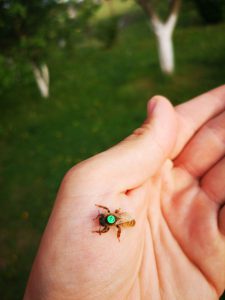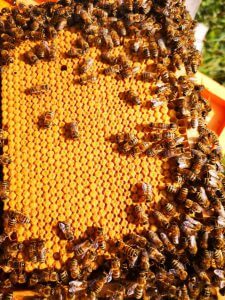Everything that a queen bee touches is special: her food, her work, her lifestyle and even her character. Besides, every queen bee is unique. She’s not called a queen bee for nothing. And even though she might seem small compared to her entire swarm, the entire colony does her bidding. So without further ado, we present Her Royal Highness, the Queen Bee.

Birth
Let’s take a look inside the hive. There, snuggling in their honeycomb cells, lie the bee eggs. It won’t be long before they hatch into starving bee larvae that will be watched over and cared for by their bee nurses. These little ones might not look very sweet to us, but to the bee colony these are the most adorable creatures that deserve royal food – royal jelly – at least for the beginning. No one knows how, but these worker bees select a few special eggs from a multitude of others that they place not in regular honeycomb cells, but substantially larger cells or chambers, and which go on to become queen bees. The regular bee larvae are fed royal jelly for 3 days, while the queen larvae are given royal jelly almost twice as long – for 5 days. The chosen one, unlike the regular larvae and bees, will feed on royal jelly for the rest of her life. It is royal jelly that turns a regular larva into a queen bee with an active reproductive system, a larger body and the right to all the privileges of the hive.
Life
Just as she hatches from her cocoon, Her Majesty the Queen Bee begins her extraordinary life journey. Her first great task along the way – to mate. Having wandered among her subjects, inspected her hive and watched the waggle dancing of her worker bees, 7–10 days after hatching, the queen bee will leave the hive with a single purpose – to find her mates. Because this flight will have to do for the rest of her life, the young queen bee mates with 20 to 30 drones, and 12 days later, begins laying her eggs and raising her new brood.

Another especially important duty of the queen bee is to spread her good energy throughout the hive. After all, no one wants to encounter a bee that got out of the wrong side of the bed in the morning. Don’t get the idea that being the ruler of a hive is easy – you might be constantly groomed, fed and respected, but you can also be betrayed. The queen bee can never rest easy – if productivity drops among them, the worker bees can grow a new queen of their own accord. And then it’s simply ‘good bye my love, good bye’. Or a fight to the death. A truly royal existence.
Farewell
When food is abundant and the nectar harvest bountiful, bees tend to swarm. The old queen, instead of fighting the new one, leaves the hive with a part of her swarm. However, this tendency depends not only on the strength of the harvest, but also on the breed of bee.
Even though queen bees spend their entire lives surrounded by vast multitudes of their offspring, when the time comes to say farewell, they often end up alone. Some die in the fight for their hive, while some die inside the hive or leave it altogether. No royal wake, celebratory handing over the crown or funeral – just concern for the new mistress of the house.
Buckfast queens are born with a mission of their own – to raise a large bee colony that not only harvests nectar but also pollinates crops and welcomes in the garden harvest. Our planet is so huge and so much depends on an insect scarcely several centimetres large – Her Royal Highness, the Queen Bee.





